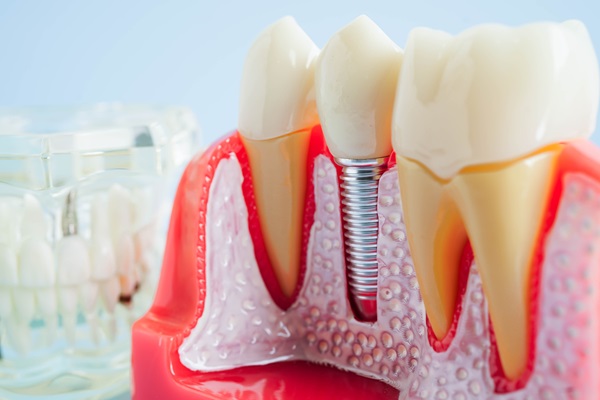How Is a Dental Implant Placed?

The placement of dental implants is an intricate process involving the insertion of titanium posts into the jawbone. The posts mimic the functions of the natural tooth roots by fusing to the jawbone and support the replacement tooth attached to them. The process involves multiple dental implants, but the process is generally worth the trouble. Continue reading to get an overview of what is involved in placing dental implants.
The implant procedure
The number of missing teeth determines the number of implants required. Only one implant is needed for a lost tooth, and four to six implants may be used to support an entire arch of missing teeth.
The process of placing one dental implant lasts between 30 to 60 minutes and about two to three hours for multiple implants. The patient’s condition will determine the length of the procedure and the number of appointments needed. The dentist will perform the needed assessment to obtain information about the patient’s situation.
Before the placement, patients may be administered a course of antibiotics, and intravenous sedation or nitrous oxide might be used to ensure comfort. The dentist will discuss these options during the initial consultation. A local anesthetic will be used around the point of implant placement.
When the patient is at ease, the dentist will create a little incision over the gum tissue to access the bone, open the space with dental tools, and insert the implant post. The head of the implant will protrude slightly through the gum. The dentist may choose to allow the gum tissue to cover the implant completely. The gum tissues will be stitched closed to complete the implant placement.
After the procedure
The healing period follows the implant placement process. The duration is hardly the same for everyone and depends on the health and quantity of the bone. Patients may experience slight pain after the procedure, but the dentist will prescribe medications to relieve the pain. If self-dissolving stitches are not used, patients will return to get the stitches taken out.
Sometimes, a restoration may be attached immediately after implant placement. The dentist will provide suggestions on follow-up care and appointments. After the bone heals around the implant – a process which may take between three to six months – the dentist will place the abutment or a healing cap on the implant. This will guide the gum tissue healing, and the abutment will serve as the connection between the restoration and the implant.
The dentist will take dental impressions and send them to a dental lab to produce the dental crown. Follow-up appointments allow the dentist to monitor healing progress and determine when the time is right to attach the dental restoration. The implant procedure ends once the crown is fitted over the dental implant.
In conclusion
The placement of dental implants is a multi-stage process. Considering that implant restorations look, function, and feel like natural teeth, the lengthy process is usually worth it. If you are considering the procedure, book an appointment with the dentist to discuss eligibility and the process.
Request an appointment here: https://www.midtowndentalclinic.com or call Midtown Dental at (509) 392-7180 for an appointment in our Richland office.
Check out what others are saying about our dental services on Yelp: Dental Implants in Richland, WA.
Related Posts
Dental implants are a highly effective solution for replacing missing or damaged teeth. They offer a permanent and durable option that not only restores the function of the teeth but also enhances the smile's appearance. As a modern and advanced treatment, dental implants have become the preferred choice for individuals seeking a long-lasting and natural-looking…
Dental restorations can help you maintain your oral health and prevent further decay. A dental filling is one of the most common restorative procedures used to treat mild to moderate cavities and other dental damage. This type of restoration restores the function and appearance of a damaged or decayed tooth. Let us walk you through…
Cosmetic dental services are transformative solutions that enhance teeth and gums' appearance and sometimes function, providing patients with a more radiant smile. These services focus on aesthetics and oral health, from correcting minor imperfections to achieving a complete smile makeover. Advancements in dental technology have made these procedures more accessible, effective, and even customizable, catering…
Learning about cosmetic dental services can prepare you for your upcoming consultation. These procedures aim to enhance your smile and oral health. Each one can elevate your quality of life. Here are the benefits to consider about the cosmetic dental services you may need.Dental veneers and in-office teeth whitening are cosmetic dental services that can…
